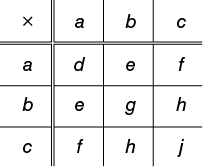题目信息

Each entry in the multiplication table above is an integer that is either positive, negative, or zero. What is the value of a ?
A:Statement (1) ALONE is sufficient, but statement (2) alone is not sufficient.
B:Statement (2) ALONE is sufficient, but statement (1) alone is not sufficient.
C:BOTH statements TOGETHER are sufficient, but NEITHER statement ALONE is sufficient.
D:EACH statement ALONE is sufficient.
E:Statements (1) and (2) TOGETHER are NOT sufficient.
参考答案及共享解析

共享解析来源为网络权威资源、GMAT高分考生等; 如有疑问,欢迎在评论区提问与讨论
本题耗时:
已选答案:
正确答案:
C:BOTH statements TOGETHER are sufficient, but NEITHER statement ALONE is sufficient.
Arithmetic Properties of integers
If a, b, c equal 1, 2, 3 in this order, then each entry will be an integer, h ≠ 0, and a = 1. However, if a, b, c equal 2, 3, 4 in this order, then each entry will be an integer, h ≠ 0, and a = 2. Hence, the value of a cannot be determined; NOT sufficient. The assumption c = f is equivalent to ac = c, or (a − 1)c = 0. Hence, c = f is equivalent to a = 1 or c = 0. If a, b, c equal 1, 2, 3 in this order, then each entry will be an integer, c = f, and a = 1. However, if a, b, c equal −2, −1, 0 in this order, then each entry will be an integer, c = f, and a = −2. Hence, the value of a cannot be determined; NOT sufficient.
Given (1) and (2), then from (1) we have bc = h ≠ 0, and hence b ≠ 0 and c ≠ 0. From (2) we have a = 1 or c = 0, but since c ≠ 0, it follows that a = 1. Hence, the value of a can be determined.
The correct answer is C;both statements together are sufficient.
If a, b, c equal 1, 2, 3 in this order, then each entry will be an integer, h ≠ 0, and a = 1. However, if a, b, c equal 2, 3, 4 in this order, then each entry will be an integer, h ≠ 0, and a = 2. Hence, the value of a cannot be determined; NOT sufficient. The assumption c = f is equivalent to ac = c, or (a − 1)c = 0. Hence, c = f is equivalent to a = 1 or c = 0. If a, b, c equal 1, 2, 3 in this order, then each entry will be an integer, c = f, and a = 1. However, if a, b, c equal −2, −1, 0 in this order, then each entry will be an integer, c = f, and a = −2. Hence, the value of a cannot be determined; NOT sufficient.
Given (1) and (2), then from (1) we have bc = h ≠ 0, and hence b ≠ 0 and c ≠ 0. From (2) we have a = 1 or c = 0, but since c ≠ 0, it follows that a = 1. Hence, the value of a can be determined.
The correct answer is C;both statements together are sufficient.
 加入收藏
加入收藏
 在线答疑
在线答疑
题目来源



























